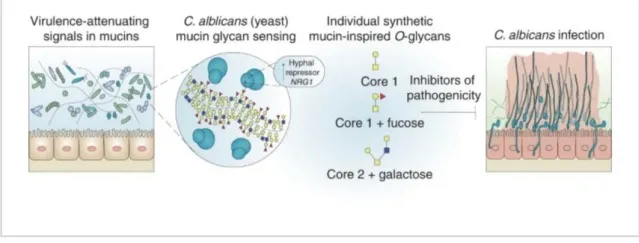Synthetic Mucin Glycans as Antifungal Agents
This technology utilizes mucus’ natural ability to repress the virulence of fungal infections such as those caused by Candida albicans, repair and maintain the bodies’ natural microbiome, and support its crucial mucus barrier.
Researchers
-
mucin glycans as antifungal agents
United States of America | Published application -
mucin glycans as antifungal agents
European Patent Convention | Pending
Figures
Technology
To determine how mucin glycans regulate C. albicans physiology, researchers performed RNA sequencing on cells grown in various kinds of mucus. Through this experiment, it was determined that all mucins participated in the downregulation of genes associated with fungal virulence. This novel treatment method, derived from these research findings, comprises a method of contacting the fungus with a mucin glycan and a pharmaceutically acceptable salt. This modulates the virulence associated genes, reduces fungus surface adhesion, and inhibits fungus’ morphological transition into virulent cells. Depending on the kind of infection, administration can be carried out in several manners including injection, ingestion, or inhalation.
Problem Addressed
Mucus forms a protective barrier over bodily cavities that contact the external environment. C. albicans is a fungal pathogen that harmlessly colonizes the body’s mucosal linings, particularly around the mouth, gastrointestinal system, and female genital tract. Alternations to the mucus barrier and changes in the microbiome can lead to C. albicans overgrowth and infection, which can be fatal. C. albicans is unique in that it can switch between a yeast form and a hyphal, or mold form, with the latter being much more virulent and damaging.
Current treatment methods for C. albicans infection consist of antifungal drugs. However, these drugs tend to have limited efficacy and their high toxicity can disrupt the body’s microbiome with serious side effects. Furthermore, fungal species tend to rapidly develop resistance to these common treatments.
To overcome these limitations, this technology leverages mucin glycans’ ability to repress C. albicans virulence without disrupting the microbiome and avoid the potential evolution of drug resistance normally associated with antifungals. Mucin glycans are protein and carbohydrate-based chains that serve as the main structural component of mucus.
Advantages
- Mucin glycans can weaken and degrade various cross-kingdom pathogens.
- Mucins can be synthetic or naturally occurring.
- This technology avoids the potential development of resistance to treatment.
- This composition lacks the toxicity of other antifungal or antibacterial treatments.
Publications
Takagi, J., et al. "Mucin O-glycans Are Natural Inhibitors of Candida Albicans Pathogenicity." Nature Chemical Biology 18 (2022): 762–773. Accessed February 14, 2022. https://doi-org.ezproxyberklee.flo.org/10.1038/s41589-022-01035-1.
License this technology
Interested in this technology? Connect with our experienced licensing team to initiate the process.
Sign up for technology updates
Sign up now to receive the latest updates on cutting-edge technologies and innovations.
